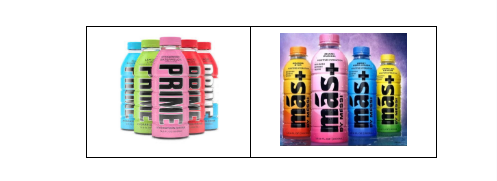Design, packaging and brands are strategic assets. Find out how to protect your brand from imitations and unfair competition.
Calculate the quote
In the multi-billion-dollar energy drink market, a legal dispute over unfair competition has erupted between two giants: Prime Hydration, the brand by Logan Paul and KSI, and Mas+ by Messi, the new beverage from the football icon.
It all started with accusations of packaging imitation, amplified by social media buzz, and eventually escalated to the courts.
But the story took an unexpected twist when Logan Paul challenged Messi to settle the issue in a boxing ring!
Is a visual resemblance enough to claim “plagiarism”?
Mas+ responded with a market survey, while Prime focused on viral storytelling.
Without a registered design, is there still a way to take legal action?
And in the end, who’s really winning this battle—the strongest, or the smartest?
The world of energy drinks has become the backdrop for a feud that goes far beyond the beverage industry.
Prime Hydration, the brand launched by YouTuber and wrestler Logan Paul alongside KSI, is now facing a heavyweight rival: Mas+ by Messi, the drink created by the legendary Argentine footballer with support from Mark Anthony Brands International (see also:
Logan Paul vs. Lionel Messi beef explained: Legal issue, chances of boxing fight happening | Sporting News – 17 febbraio 2025).

From the moment Mas+ was announced, the similarity in packaging sparked backlash.
Logan Paul publicly reported the risk of consumer confusion, fueling discussions across social and mainstream media alike. The conflict didn’t stop at words: it made its way into the courtroom.
Then came the surprise twist: Logan Paul challenged Messi to a boxing match to settle the matter! A provocation? A marketing stunt? Or an attempt to shift attention from the legal battle to a more spectacular arena?
The legal dispute between Prime Hydration and Mas+ by Messi is rooted in a clear accusation: the two products look too much alike. The main issue? The trade dress—the combination of distinctive visual elements that define a product, such as packaging, colors, and bottle shape.
It all began when several consumers, especially in Latin American countries, started tagging Prime Hydration on social media, sharing photos of Mas+ and mistaking it for a local version of Logan Paul’s drink.
According to Paul and KSI, this shows a level of confusability that could mislead consumers into believing the two brands are related, or that Mas+ is a sub-brand of Prime.
On the other hand, Mark Anthony Brands International responded with hard data: to prove that the resemblance doesn’t cause confusion, the company commissioned a market study, analyzing consumer perception. According to the research, the design differences are sufficient to clearly distinguish the two brands, making Logan Paul’s claims unfounded.
But is this controversy only about looks? Or are there specific legal standards to determine whether this is a case of slavish imitation?
Typically, companies protect their products by registering trademarks, designs, and trade dress, to prevent competitors from copying them freely. However, in the case of Prime Hydration, there’s a key detail: Logan Paul did not register the product’s design or packaging. Can he still accuse Mas+ of imitation?
The answer isn’t so straightforward. Even without formal registration, there are legal tools to protect a product from being copied.
Under Italian law, for example, protection can be enforced through unfair competition rules (Art. 2598 Italian Civil Code), which prohibits slavish imitation – i.e. the unauthorized reproduction of a product that can confuse consumers.
But is imitation always illegal? Not necessarily: if the copied design follows a standard form used in the industry, then resemblance alone isn’t enough to claim a violation. In the energy drink sector, many bottles share similar shapes due to practical or marketing reasons. To prove misconduct, Prime would need to show that its bottle design was distinctive enough to be instantly recognizable and uniquely linked to its brand.
Meanwhile, Mas+ responded with a smart legal strategy: the company asked the court for a negative declaratory judgment, a ruling that confirms no unlawful imitation took place. If granted, this would shield Messi’s brand from future claims and secure its position in the market.
But what kinds of violations are really on the table here? Is it just about product confusion, or could there be reputational damage and aggressive marketing tactics involved too?
It’s true that Prime Hydration and Mas+ by Messi bottles look somewhat alike. It is also true that in the energy drink market, similar packaging elements are common. The core of this dispute isn’t just about design. The real battle lies in marketing strategies, branding, and public perception.
On one side, Prime chose to ride the media wave, leveraging the fame of Logan Paul and KSI to turn a legal case into a viral story. The boxing challenge to Messi is just another chapter in a carefully crafted narrative. A way to keep the brand in the spotlight, no matter the legal outcome.
On the other side, Mas+ opted for a more traditional and legally grounded approach, seeking a court ruling to dismiss Prime’s claims and defend its market position. A favorable judgment would settle the dispute and leave Prime with a legal and reputational loss.
Perhaps, beyond courts and boxing rings, the real winner has already emerged: thanks to this clash, both brands have achieved unprecedented visibility. No matter who ends up being right, everyone now knows Prime Hydration and Mas+. And in the world of marketing, there’s no better advertisement than a well-played rivalry.
Gabriele Rossi
